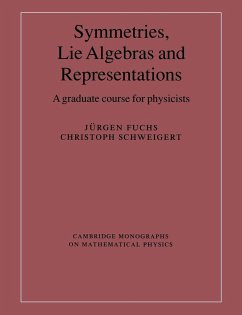A graduate level introduction to Lie algebras and their applications in physics.
This is an introduction to Lie algebras and their applications in physics. The first three chapters show how Lie algebras arise naturally from symmetries of physical systems and illustrate through examples much of their general structure. Chapters 4 to 13 give a detailed introduction to Lie algebras and their representations, covering the Cartan-Weyl basis, simple and affine Lie algebras, real forms and Lie groups, the Weyl group, automorphisms, loop algebras and highest weight representations. Chapters 14 to 22 cover specific further topics, such as Verma modules, Casimirs, tensor products and Clebsch-Gordan coefficients, invariant tensors, subalgebras and branching rules, Young tableaux, spinors, Clifford algebras and supersymmetry, representations on function spaces, and Hopf algebras and representation rings. A detailed reference list is provided, and many exercises and examples throughout the book illustrate the use of Lie algebras in real physical problems. The text is written at a level accessible to graduate students, but will also provide a comprehensive reference for researchers.
Table of content:
Preface; 1. Symmetries and conservation laws; 2. Basic examples; 3. The Lie algebra su(3) and hadron symmetries; 4. Formalization: algebras and Lie algebras; 5. Representations; 6. The Cartan-Weyl basis; 7. Simple and affine Lie algebras; 8. Real Lie algebras and real forms; 9. Lie groups; 10. Symmetries of the root system. The Weyl group; 11. Automorphisms of Lie algebras; 12. Loop algebras and central extensions; 13. Highest weight representations; 14. Verma modules, Casimirs, and the character formula; 15. Tensor products of representations; 16. Clebsch-Gordan coefficients and tensor operators; 17. Invariant tensors; 18. Subalgebras and branching rules; 19. Young tableaux and the symmetric group; 20. Spinors, Clifford algebras, and supersymmetry; 21. Representations on function spaces; 22. Hopf algebras and representation rings; Epilogue; References; Index.
This is an introduction to Lie algebras and their applications in physics. The first three chapters show how Lie algebras arise naturally from symmetries of physical systems and illustrate through examples much of their general structure. Chapters 4 to 13 give a detailed introduction to Lie algebras and their representations, covering the Cartan-Weyl basis, simple and affine Lie algebras, real forms and Lie groups, the Weyl group, automorphisms, loop algebras and highest weight representations. Chapters 14 to 22 cover specific further topics, such as Verma modules, Casimirs, tensor products and Clebsch-Gordan coefficients, invariant tensors, subalgebras and branching rules, Young tableaux, spinors, Clifford algebras and supersymmetry, representations on function spaces, and Hopf algebras and representation rings. A detailed reference list is provided, and many exercises and examples throughout the book illustrate the use of Lie algebras in real physical problems. The text is written at a level accessible to graduate students, but will also provide a comprehensive reference for researchers.
Table of content:
Preface; 1. Symmetries and conservation laws; 2. Basic examples; 3. The Lie algebra su(3) and hadron symmetries; 4. Formalization: algebras and Lie algebras; 5. Representations; 6. The Cartan-Weyl basis; 7. Simple and affine Lie algebras; 8. Real Lie algebras and real forms; 9. Lie groups; 10. Symmetries of the root system. The Weyl group; 11. Automorphisms of Lie algebras; 12. Loop algebras and central extensions; 13. Highest weight representations; 14. Verma modules, Casimirs, and the character formula; 15. Tensor products of representations; 16. Clebsch-Gordan coefficients and tensor operators; 17. Invariant tensors; 18. Subalgebras and branching rules; 19. Young tableaux and the symmetric group; 20. Spinors, Clifford algebras, and supersymmetry; 21. Representations on function spaces; 22. Hopf algebras and representation rings; Epilogue; References; Index.








